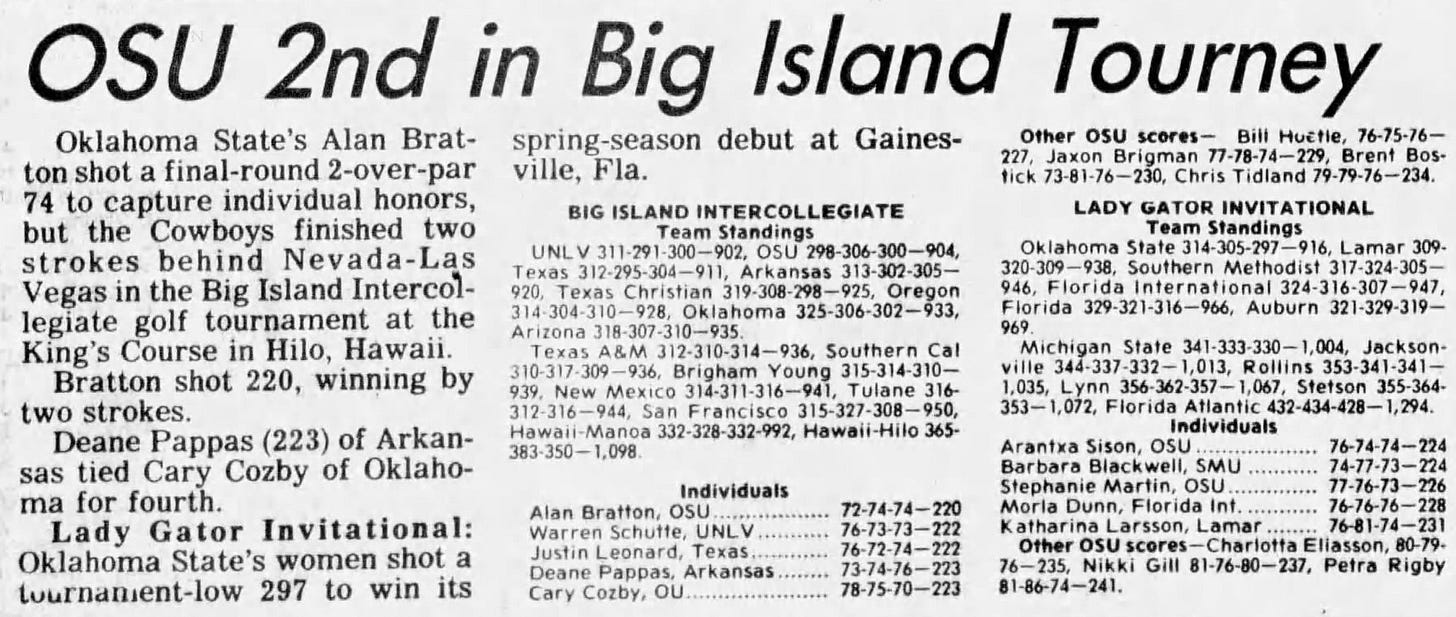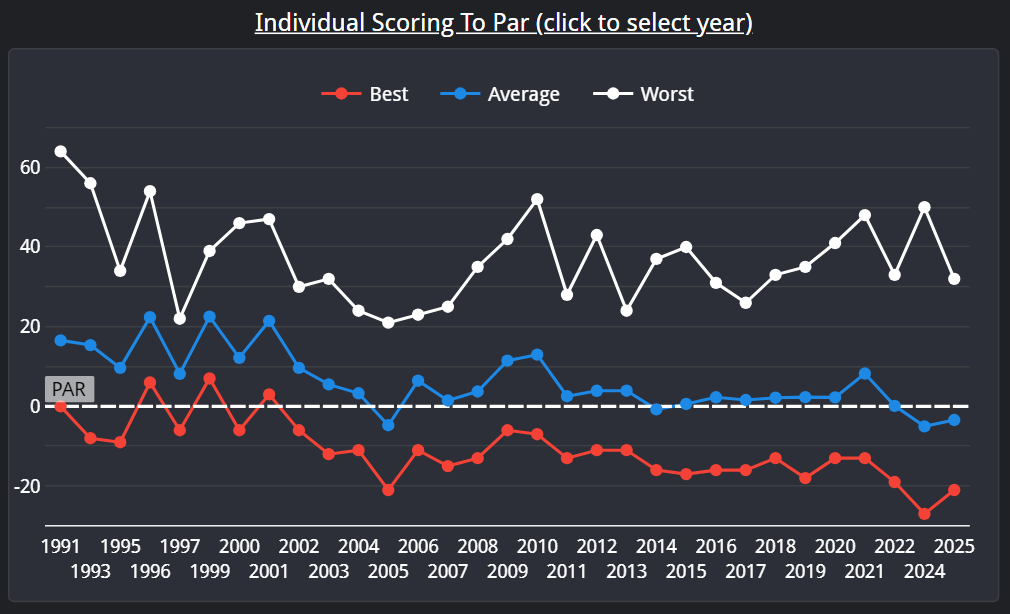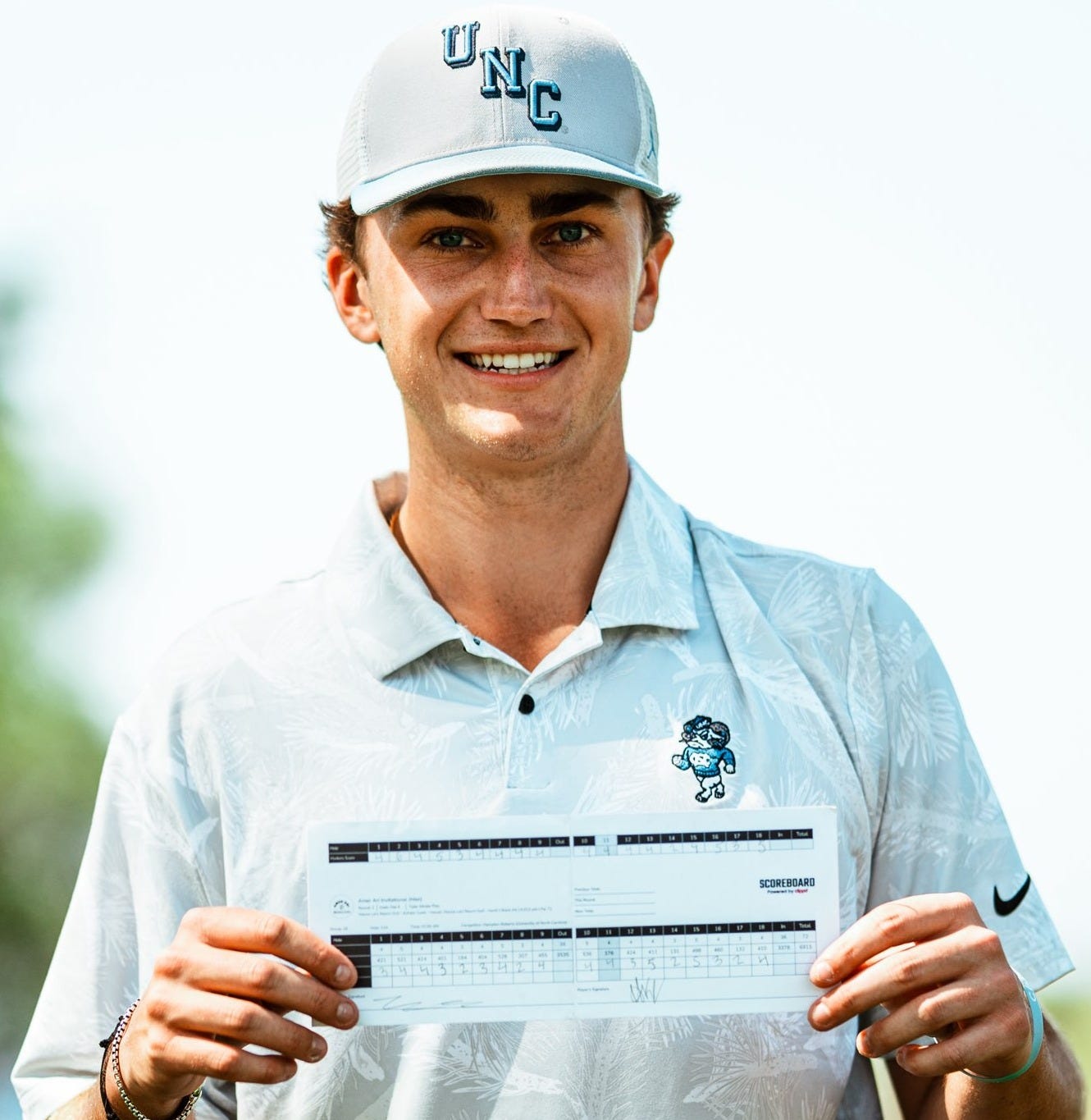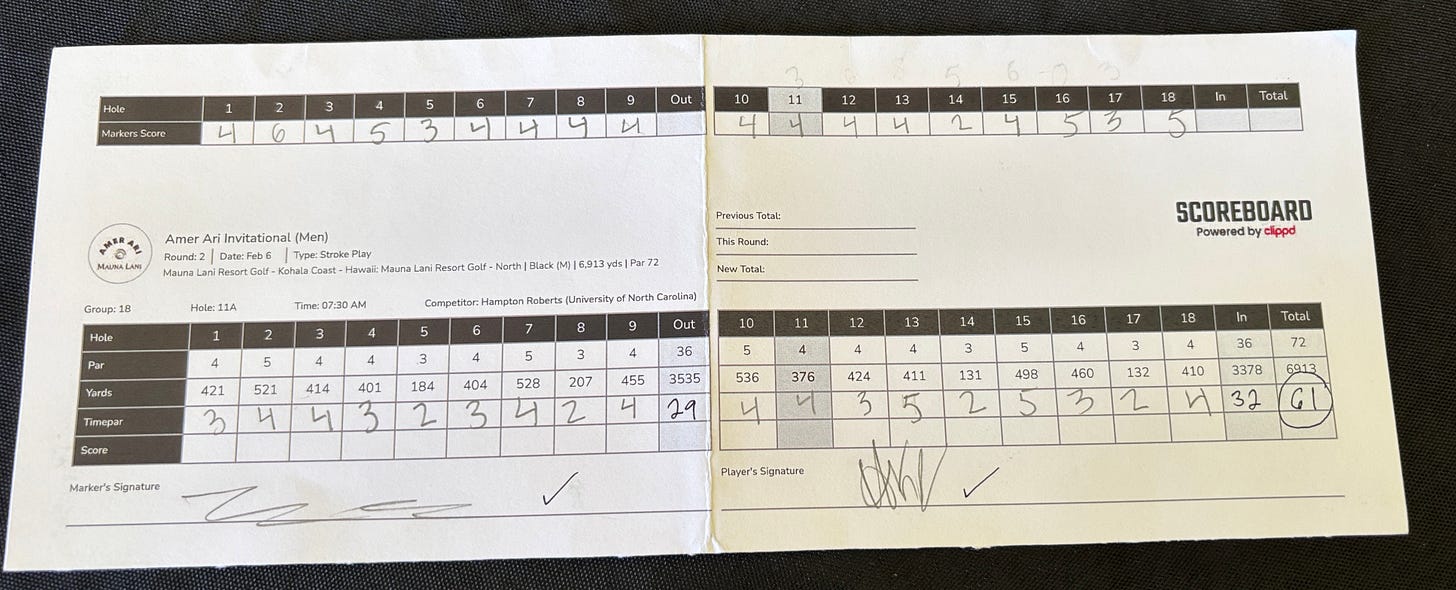Future Pro Island - Revisiting the Amer Ari
Insights From Coaches and Scoring Across Three Decades
Recently, David and I released our Amer Ari tournament data dashboard, creating a way for anyone to look back through most of the tournament results from 1991-2025. Today, we dig a little deeper into the numbers using this dashboard. Having 30+ years worth of tournament data in which some of the best players have competed allows us to explore some pretty interesting things. We hope you enjoy!
THERE’S A 65% CHANCE THE INDIVIDUAL WINNER AT THE AMER ARI IS A FUTURE TOUR PLAYER
In the 34 editions of the tournament, there have been 22 individual wins by future touring pros. If we exclude this year’s winner (Tommy Morrison - Texas) as he’s still in college, 65% of Amer Ari winner is either currently or in the past a player on either the PGA Tour, DP World Tour, or LIV Tour.

In addition to winning three straight U.S. Juniors, another fact Tiger Woods and Jordan Spieth share is they’ve both lost in playoffs for the individual win at the Amer Ari. You can bring that one up next time you need a golf fun-fact.
PGA Tour players Patrick Cantlay and Rico Hoey have also lost playoffs here. The tour-player history at this island-golf event is almost unbelievable.
Speaking of Cantlay, he owns the tournament record for the largest comeback for a co-medalist. The UCLA freshman opened with 74/+2 which was 1.6 strokes WORSE than the field average and 12 strokes behind leader. He then followed up with rounds of 64/-8 and 65/-7 to finish at 203/-13 to get into a 3-way tie; ultimately losing to Daniel Miernicki [Oregon] on the 7th playoff hole.
THE FIRST EDITION (1991)
In the inaugural Amer Ari tournament of 1991, Jean-Paul Hebert (Texas, now UNLV Head Coach) finished T7 individually. Coach Hebert still remembers the event vividly, emphasizing that the wind was the story of that first edition. “It never laid down. The wind blew every day—not gusty, just a constant wind.”
That year, OSU’s Craig Hainline shot a final-round 71 (-1)—a score that might not seem remarkable at first glance. But considering it was 9.21 strokes better than the field average that day, it stands as one of the great rounds in tournament history.
In fact, Hainline’s final round remains one of the top three final rounds ever at the event—only bettered by Eugenio Chacarra’s 62 in 2022 (+10.4 strokes gained) and Brooks Koepka’s 65 in 2010 (+9.5 strokes gained).
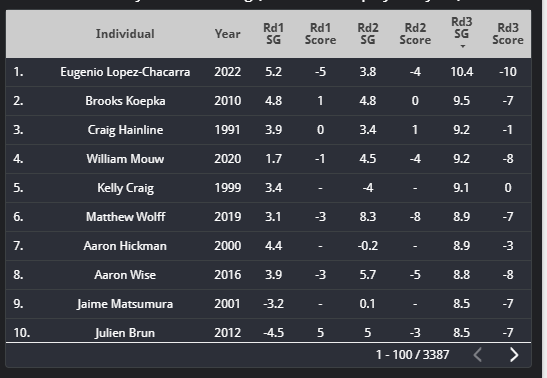
Coach Hebert shared a takeaway from that tournament that still resonates today. “Always thought of that as a lesson,” he told David over the phone, “There will always be someone in the field who finds a way to shoot under par that day. I tell my guys—that could be you.”
The young Longhorn wasn’t the only one to encounter that brutal Hawaiian wind and learn that lesson. The next year, Oklahoma State freshman Alan Bratton earned his first collegiate win in similar conditions:
“In 1992 the wind howled. Some of the hardest wind I’ve ever seen. I am pretty sure I shot 72 in round 1 and was leading by 4-5 shots. I ended up shooting 4 over for the tournament and won by 2. That’s how hard the wind blew. The guys that finished tied for second both played the PGA Tour.” Those two future PGA Tour players were none other than defending NCAA champion 1991) Warren Schutte [UNLV] and future NCAA champion (1994) Justin Leonard [Texas].
MORE STROKES GAINED
Here are the best individual SG rounds
10.97 by Jim Skinner [SMU] in 1996 (rd1) with 76/+4
only 4 other players broke 80! (2 @ 78 and 2 @ 79)
10.74 by Drew Kittleson [FSU] in 2009 (rd2) with 66/-6
10.73 by Hampton Roberts [UNC] in 2025 (rd2) with 61/-11
10.57 by Blake Wagoner [ASU] in 2021 (rd1) with 63/-9
10.40 by Daniel Miernicki [Oregon] in 2011 (rd1) with 62/-10
10.36 by Eugenio Lopez-Chacarra [Ok St] in 2022 (rd3) with 62/-10
10.14 by Rodolfo Estrada [UH-Hilo] in 2009 (rd1) with 66/-6
Players who have reached 20-under-par for the tournament
2024 Wenyi Ding [ASU] shot -27/189 to win by 9 (SG = 21.99)
Not only was this an NCAA record setting score and score-to-par, Ding set another less obvious record with his 9 stroke victory over another player breaking the 200/-16 barrier
2005 Tyler Leon [Ok St] shot -21/195 to win by 3 (SG = 16.26)
2025 Tommy Morrison [Texas] shot -21/195 to finish T1 (won playoff) (SG = 17.57)
2025 Hampton Roberts [UNC] shot -21/195 to finish T1 (lost playoff) (SG = 17.57)
SCORING FLUCTUATIONS
A tournament running for this long brings to light some pretty interesting differences in the college golf scoring over the decades, which is one reason we spend so much time looking at the SG values rather than strictly the raw scoring. This can be due to a number of things such as the wind, better equipment, and even the course conditions or course change. Below are two graphs looking at the end-of-tournament scoring relative to par.
Since the trendlines aren’t as clear to see on the individual side, we thought it might be helpful to have context on the SG values by including the worst scoring each year as well. You can see how there is a larger separation between the winning score and average score on the years when the worst score is so much higher, but relatively speaking that really isn’t as drastic of a separation as one might expect.
The scoring trend for the teams as a whole is quite clear, moving gradually downward. Even with the technology advancement, there are still years where the wind and course setup have taken their toll on scoring. Looking closely, it’s interesting to note that the trendlines are moving mostly in parallel, moving slightly closer together as average scoring is improving relative to the winning score each year.
TEAM SCORING
As seen in the graphs above, the scores have fluctuated drastically to the point where you have winning team scores that range from:
lowest = 796/-68 by 2024 UNC which is an avg counting score of 66.33
highest = 911/+47 by 1996 Ok St which is an avg counting score of 75.92
Here are some of the best team performances relative to rest of the field with known par and played same course (in other words, not the 1998-01 1st and 2nd rounds where teams swapped courses between rounds)
1992 UNLV - rd2 291/+3 (22.81 SG)
1992 Oklahoma State - rd1 298/+10 (~20 SG)
2021 USC - rd2 278/-10 (~20 SG)
2021 Arizona State - rd2 275/-13
Shot same score as rd1 but was a MUCH bigger SG (23.63 in rd2 vs 12.15 in rd1)
After that round they had 4 players in the top 5
Finished tournament with: 1 (David Puig), T2, 4, T7, T10, 14
2022 Oklahoma State - rd3 264/-24 (19.84 SG)
Jumped from 5th place up to first to win by 1 stroke
WINNING HERE MEANS MORE THAN YOU THINK
We mentioned this is our post on the history of the tournament prior to 2025, but given the talk about the strokes gained relative to field average, it’s worth repeating:
Any tournament with a field perpetually this strong is going to have a great connection to the NCAA championship. In fact, six teams - 1991 Oklahoma St, 1995 Ok St, 1998 UNLV, 2007 Stanford, 2012 Texas, and 2018 Ok St - have won the NCAA championship just a few months after taking home the Amer Ari team title. Furthermore, four players have won both Amer Ari and NCAA medalist honors in the same season: 1993 Todd Demsey [Arizona St], 2002 Troy Matteson [Georgia Tech], 2016 Aaron Wise [Oregon], and 2019 Matt Wolff [Ok St].
Since the addition of match play to decide the NCAA team championship, three Amer Ari team champs - 2018 Ok St, 2019 Ok St, and 2021 Arizona St - have gone on to earn the #1 seed at NCAAs. That’s a cool stat, but what’s even more impressive is that since that format change in 2009 **at least one team from the Amer Ari field every year has gone on to make the match play portion of NCAAs! The average number of teams each year is about 3, with the most being in 2010 when seven of the eight match play teams had competed in Hawaii a few months prior; the only team not at Amer Ari was Augusta who ended up winning the first of their two consecutive NCAA championships.
COMPARING 2005 & 2025
The move from Waikoloa Beach (which has hosted the tournament for most of the event’s history) to Mauna Lani in 2024 has resulted in undeniably lower scores. That said, there are some interesting parallels between the most recent tournament and 20 years prior when the wind died down and teams took full advantage of the Waikoloa Village course.
On the team side of things, the 2025 Oklahoma State Cowboys set a new program record for lowest 54-hole score and score to par with their 800/-64 first place finish. The record they beat? The 2005 Cowboy team also won this tournament with a final score of 801/-63!
Beyond just their final score, the 2025 team might have also set a program record with their final round drop score of 68/-4. This was the second-lowest team drop score in tournament history behind Georgia Tech’s 67/-5 in the final round last year.
Oklahoma State Head Coach Alan Bratton was also on the Big Island for the OSU win in 2005 as an assistant coach to legendary Coach Mike Holder and had this to say:
“In 2005 we went up the hill to the Village course. Super easy but we blitzed it. I told our guys someone would shoot 199 and that would be a great goal. 17 under for the event. We had 3 guys shoot that or better and we set a record for Oklahoma State for low team score and I think Tyler Leon won at 195. I’ll never forget Coach Holder saying ‘we almost shot in the 700’s’ he’s never seen that before and we won going away.
This year our guys did a good job or restarting every day with the mindset to shoot as low as we can. We had 3 different guys shoot the low score of the day for us in the week. We set or tied 3 OSU records. Low single round individual score 62. Low single round for team -26. Low total score -64.”
Oklahoma State wasn’t the only team setting program records this year. Runner-up UNC had their second lowest program team score and score to par with their 805/-59 finish; behind their 2024 Amer Ari total of 796/-68! Texas set new records for team score and score to par with their 808/-56 third place finish. Oregon broke their team score to par with their -48/816 finish. Auburn’s -27/261 is the best closing round score-to-par in tournament history, matching their round 2 -27/261 from 2024 which broke the tournament record for any round.
There were records on the individual side as well, most notably from UNC’s Hampton Roberts who set a new tournament record, course record, and team record (raw score, tied their to-par record) with his second round 61/-11.
Roberts would go on to finish in a tie for co-medalist honors at 195/-21. This was the same score shot by Oklahoma State’s Tyler Leon in 2005, but over a full stroke better relative to the field average. This set more team records for Roberts. Unfortunately, after losing on the first playoff hole, this also put Roberts in some company he didn’t want to keep as being one of the lowest known non-winning scores:
Lowest to par: -21/195 by Espen Kofsted [Denver] at 2007 Air Force Invitational
Lowest raw score: 193/-20 by Quade Cummins [Oklahoma] at 2021 Ka’anopali Classic
The other co-medalist and ultimate individual winner was Tommy Morrison of Texas. Morrison collected his first collegiate victory while scoring one of the best (unconfirmed if actual best) 54-hole scores and scores to par in Texas history.
We hope you enjoyed getting to know more about this fantastic event! We intend to do more of these deep dives soon. Let us know what tournament you’d like to see covered and if there’s any stats or data topics you’re curious about.
Have a great week!
If you’d like to support my work further, please consider becoming a paid subscriber. In addition to supporting my writing and website work, paid subscriber get access to all of the player development tools on www.mikkelgolf.com. The tools available include a library of performance drills and on-course formats, plus an on-course stats system designed to improve approach play and putting. Five division one golf programs currently use the stats portal. Reach out for more details if you’re interested!
If you enjoy learning more college golf history, consider also subscribing to David’s newsletter







